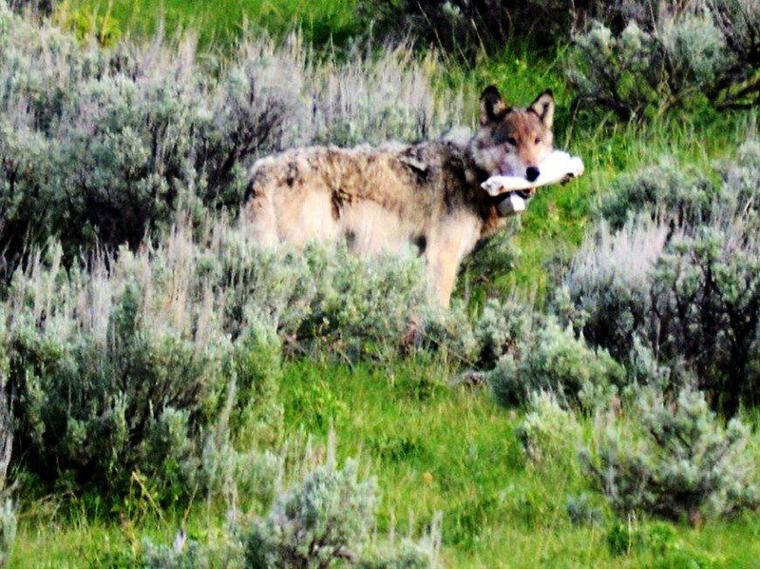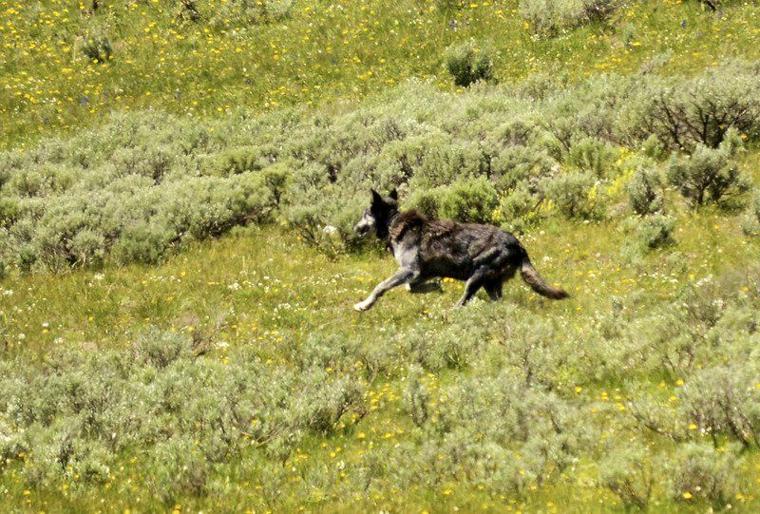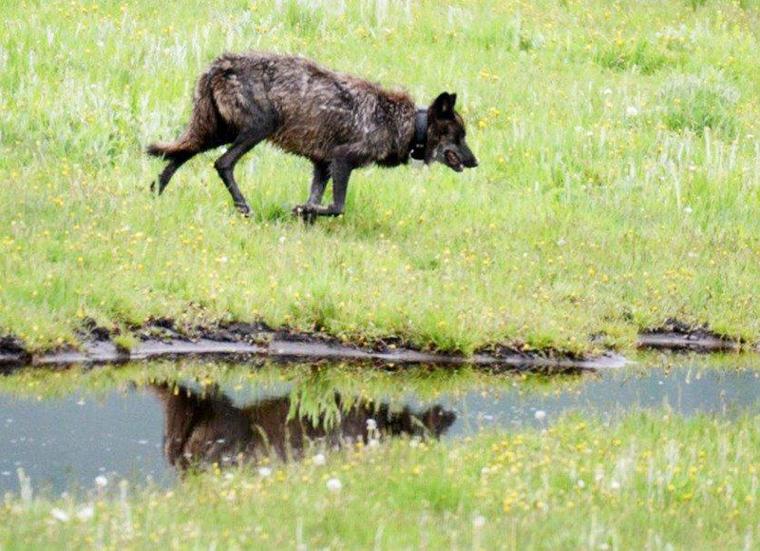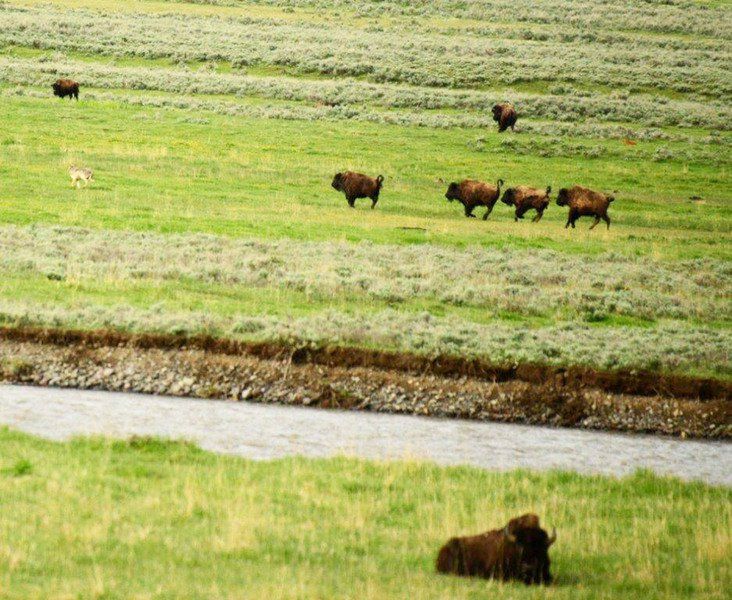Posted: Thursday, August 20, 2015

It was 2 a.m., and I couldn’t escape the sharp about-face in my circumstances.
Two days earlier, eating trout at Roosevelt Lodge, I was at the top of the food chain.
But in my tent at a backcountry campsite in the northwest corner of Yellowstone National Park, getting a call from Mother Nature, I couldn’t stop thinking about the new order of things.
Park studies put Yellowstone’s grizzly population at that time at about 600, with a similar number of black bears. The wolf population they estimated at 170, as well as an unknown number of cougars, probably several dozen, most in the northern range. That’s about 1,400 meat eaters sharing the backcountry with me.
The rational part of my mind knew that carnivore attacks in Yellowstone are rare, especially if you play by the rules. Even though there was a fatal attack just this month, one study calculated the odds of being injured by a bear in the park at 1 in 2.1 million. The odds of dying in a car crash in the park are much higher.
But at 2 a.m. on a moonless Yellowstone night, busted down on the food chain, the presence of these large predators was drilling deep into my primal fears.
I slipped out of the tent, took care of business, then raced back, diving head first through the tent opening like I was Pete Rose. Then I waited. Nothing. No movement. No sound of something grunting through the grass and brush. No heavy breathing (except my own). Eventually, I drifted off to sleep. Come dawn, everything looked better.
That’s Yellowstone. Beautiful, weird, terrifying, and with the restoration of gray wolves 20 years ago, perhaps the most intact ecosystem in the lower 48, the one place where everything that is supposed to be there is there.

Since gray wolves were reintroduced in Yellowstone National Park, scientists have seen a change in many other animal populations in the park, including an increase in Beaver and waterfowl.Photo courtesy Becky Wylie
Trophic cascade
Maybe you’ve read about changes that have come to Yellowstone since the wolf was restored in the park, or maybe you’ve been one of the millions to watch the video that explains what the wolf has meant there.
The outline is this: The return of the gray wolf changed the browsing habits of elk and deer, prompting them to abandon areas where they were vulnerable, resulting in a dramatic explosion of aspen, willow, alder and other trees they had been overgrazing for decades.
Studies found aspen recruitment and expansion in areas of the park for the first time in 60 to 70 years — about the time the last wolves were trapped in Yellowstone. With the resurgent forests, populations of insects, birds and other mammals shifted. Some, such as pronghorn, prospered; others, including coyotes, fared poorly.
The beaver population increased 12-fold in parts of the park. Beavers meant more waterfowl — a 75-fold increase, and so on.
Scientists call it a trophic cascade.
And with those new forests stabilizing stream banks and those beavers working as natural engineers, not just the natural community was changing, but the return of the wolves was actually altering rivers, changing the geography of the park, the land itself. Some scientists are skeptical that everything has happened that neatly.
Time will tell, but the case is compelling.
Even before the 1995 reintroduction of wolves in that park, conservationists and biologists knew there was much truth in the theory that ecosystems — both terrestrial and marine — are regulated from the top down, and they were making the case that the removal of a natural community’s apex predator sent vibrations throughout that community, destabilizing it. Humans are not indifferent bystanders, either, but heavily invested in the outcome of these shifts.
To take one example, deer populations explode when predators are removed. More deer mean more ticks, more ticks mean more disease.
“High population densities of deer also favor the transmission of infectious agents,” including Lyme disease, concludes one report by the University of Wisconsin titled “Ecological Impacts of Deer Overpopulation.” It notes that the increase in Lyme disease in the eastern United States tracks neatly with increases in deer densities.

Besides their impact on America's oldest national park, the return of gray wolves to Yellowstone also has created a tourism boom.Photo courtesy Becky Wylie
Diversity at risk
Another of the consistently observed results across communities around the world that have lost their top predator and tilted out of balance is the subsequent loss of diversity, both plant and animal. One study found that when deer reached a density of 20 per square mile, the bird population dropped by a third, according to Willaim Stolzenburg, author of “Where the Wild Things Were.” (Just a couple of years ago, Missouri, at nearly 70,000 square miles, had 1.4 million deer; the population has dropped some since then.)
The great scientist, E.O. Wilson, in his book, “The Diversity of Life,” laid out the case for diversity: “It is fashionable in some quarters to wave aside the small and obscure, the bugs and weeds, forgetting that an obscure moth from Latin America saved Australia’s pastureland from overgrowth by cactus, that the rosy periwinkle provided the cure for Hodgkin’s disease and childhood lymphocytic leukemia, that the bark of the Pacific yew offers hope for victims of ovarian and breast cancer, that a chemical from the saliva of leeches dissolves blood clots during surgery, and so on ...” Wilson also told the story of a species of maize (wild corn) that was found in Mexico in the 1970s. It showed great resistance to disease and was unique in the fact that it demonstrated perennial growth. If it could be crossbred with domestic varieties of corn, it could boost production by billions of dollars and help feed the world.
When it was discovered, it existed in a couple small areas and was being threatened with extinction. We have known for 70 years or more that the loss of diversity follows directly and predictably the breakdown of natural communities when the apex predator is removed. We have known this going back to the work of Aldo Leopold, who argued that the wolf understood its role in the natural community better than the humans who were eradicating them. That’s what he meant in his essay on thinking like a mountain.
Red Wolf
At 2 a.m., back in my comfortable bed, back at the top of the food chain, I wondered what is to come of the red wolf. It once roamed throughout the Southeastern United States but was wiped out east of the Mississippi River by World War II. One of the places where it survived the longest — into the 1950s and perhaps into the 1960s — was in the Ozarks. This area was one of its last holdouts.
Even though the red wolf has been the focus of intense, aggressive conservation efforts for half a century now, the shadow over it is darkening. The only recovery effort — in eastern North Carolina — is being re-evalutated. The U.S. Fish and Wildlife Service is looking for alternative homes, but frankly, the red wolf appears to be out of options.
Which is ironic because just as we are beginning to understand the impact gray wolves have in the northern Rockies, we are at risk of losing its cousin, without understanding its role.

Bison are wary of one of the gray wolves in a river valley in Yellowstone National Park. Photo courtesy Becky Wylie
The impact of the red wolf has not been the focus of intense scientific study the way the gray wolf has in Yellowstone, yet there is plenty of anecdotal evidence it may send vibrations through its community, too.
Some landowners in North Carolina are opposed to the red wolf recovery effort because deer and other game species have become more scarce, which is what should happen. Others are noting the reduction in numbers (and damage) by non-native, destructive nutria in North Carolinia. There’s also reason to suspect that even sea turtles are faring better because red wolves regulate raccoon populations and so on.
What if the best way — the natural way — to keep down the spread of diseases and ensure diversity throughout the red wolf’s former range — including the Ozarks — is to make a home for it?
Leopold wrote: “If the biota, in the course of aeons, has built something we like but do not understand, then who but a fool would discard seemingly useless parts? To keep every cog and wheel is the first precaution of intelligent tinkering.”
I now understand there is something more frightening than a world where apex predators share the backcountry with me in the middle of the night, and that is a world where they don’t. Andy Ostmeyer is the metro editor at the Globe.
source


No comments:
Post a Comment